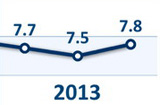Broadcom working on next network convergence effort
Updated: 2013-08-27 06:50
China's network upgrading will exceed 140b yuan in 2015 in market value
United States-based Broadcom Corp, a global leader in semiconductor products for wired and wireless communications, aims to work closely with China on the country's next network transformation effort.
"China is at the nexus of converging television, Internet and telecom markets. Broadcom is playing an important role in China's nationwide triple-network convergence effort," Li Tingwei, Broadcom's president for Greater China, told China Daily.
Network convergence aims to combine telecommunications, broadcast and Internet services on a single platform to deliver voice, data and video content to devices.
The triple-network convergence market in China is expected to exceed 140 billion yuan ($22.87 billion) in 2015 due to increased demand for front-end, access and terminal equipment for TV/broadcasting network transformation, according to the China Securities Journal.
"This presents tremendous opportunities for Broadcom, the worldwide leader in networking and broadband technology" including ethernet, passive optical networks and set-top boxes, Li said.
He said China is a "strategically important market" for Broadcom as the country is one of the world's fastest-growing economies and has the largest number of users of broadband and smartphone users.
Founded in 1991, Broadcom had an initial public offering in April 1998. In 2012, its net revenue was $8.01 billion.
In the past 20 years, Broadcom has acquired nearly 50 companies around the world and become a Fortune 500 company with about 11,750 employees globally.
Broadcom opened its Shanghai office in 2002, and it now has nearly 600 staff in five offices in the Chinese mainland: Shanghai, Shenzhen, Beijing, Nanjing and Dalian.
On July 8, Li joined Broadcom in Shanghai. He earned a doctorate in experimental physics from Leiden University in the Netherlands, a master of science degree from the Chinese Academy of Science and a bachelor of science degree from Shanghai Jiao Tong University.
"We expect to increase our investment in China and bring more innovative technologies to our Chinese customers in years to come," he said.
Li said the Chinese partners for Broadcom include the country's leading networking gear manufacturers, consumer electronics, original equipment manufacturers and mobile operators.
For example, ZTE Corp, China's second-largest telecom equipment and mobile phone maker, recently selected Broadcom's small-cell baseband processor family to integrate into its third-generation small-cell residential access points.
Broadcom's small-cell baseband processors provide high performance and with low power use, which accelerates the deployment of ZTE's small-cell end-to-end solutions.
By integrating Broadcom's small-cell baseband technology into its new access points, ZTE has significantly shortened time-to-market.
This enables ZTE to provide better service with fewer installation costs by optimizing the 3G network total spectrum capacity and limiting interference between the 3G macro network and the high volume of 3G residential small cells, Li said.
Broadcom is also making high-performance, affordable smartphones for consumers in China, he said.
Broadcom's C-DOCSIS solution, an access network standard certified by the Chinese government, has been widely adopted and deployed by many of the leading set-top box manufacturers and cable operators in China.
Broadcom is also at the center of China's converging TV, Internet and telecom markets and is poised to take advantage of technology trends including the next generation broadcasting, digital TV transition, high-definition TV, growth in broadband and the rise of low-cost smartphones.
"Our China strategy is to continue to work closely with leading Chinese OEMs and carriers, making our customers successful either in innovation, market share growth or time-to-market," Li said.























